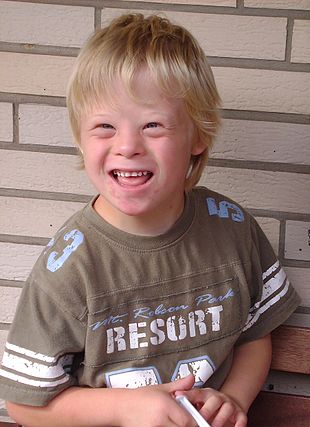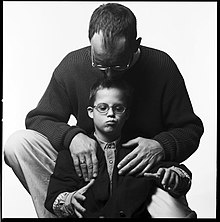Down syndrome
![]()
Mongoloid is a redirect to this article. For an obsolete racial term, see Mongolids.
![]()
Trisomy 21 is a redirect to this article. For the French synth wave band, see Trisomy 21 (band).
Trisomy 21 or Down syndrome is a genetic disease that manifests itself in a combination of mental retardation and physical malformations of varying severity and severity. The cause lies in a defect in the genetic material of the affected person (genomic mutation, chromosomal aberration or aneuploidy). In this case, chromosome 21 (chromosomes are components of cells on which hereditary information is stored) or parts of it are present three times instead of twice. This chromosomal disorder is therefore called trisomy 21 (from ancient Greek τρία tría, German 'three, threefold' and σῶμα sôma, German 'body'; here: Chromosome body No. 21, as the carrier of hereditary information). Triplications of chromosomes can occur when cell division proceeds in such a way that instead of one chromosome, two chromosomes of the same number enter the germ cell. The fertilised egg cell then has a total of three chromosomes (because another chromosome has been added): One each from the mother and father and an additional one from either the mother or the father.
As the mother gets older (especially after the age of 35), the risk of the child having trisomy 21 increases. People with Down syndrome usually have typical physical features and are usually impaired in their cognitive abilities, i.e. their thinking skills. The malformations and impairments can vary in severity.
The triplication of the corresponding genetic material usually occurs due to a mis-segregation, the lack of separation of the chromosomes during meiosis (cell nucleus division). The various forms of trisomy 21 either arise spontaneously or can be inherited if the mother already has Down syndrome herself. A translocation trisomy (through chromosome displacement) can, however, occur in families if one parent is predisposed, i.e. if there is a balanced translocation of a 21st chromosome in one parent without the symptoms of Down's syndrome.
According to the current state of research, an unambiguous prenatal diagnosis is possible by examining the fetal chromosomes, which are obtained by amniocentesis (amniocentesis) or chorionic villus sampling (placentocentesis), and less frequently by cordocentesis. Since 2012, traces of fetal genetic material can be found and examined by blood tests in the mother. The possible selection through abortion is ethically controversial.

Portrait of Chris Burke, who has a mild form of trisomy 21, at age 42.

Eight-year-old boy with trisomy 21
Designation
The name Down syndrome refers to the British physician and pharmacist John Langdon Down, who first described this syndrome comprehensively in 1866. The name originally chosen by Down was English Mongolian idiocy (from which the term Mongolism is derived), because he suspected that the syndrome was a regression to a Mongolian tribe, because of the facial features characteristic of Down syndrome and the shape of the eyes, reminiscent of members of an Asian ethnic group of "Mongols". In 1965, Mongolia submitted a request to the World Health Organization (WHO) to stop using the term Mongolian Idiocy and its derivatives because of the negative as well as racist connotations. The WHO unanimously accepted this request. Already in 1961, the renowned British scientific journal The Lancet, at the request of an international group of nineteen recognized geneticists, had changed the term to Down's Syndrome. Use of the term mongolism gradually declined and disappeared in the early 1980s; since then it has been used only in articles on the history of the syndrome. The term Down syndrome is the most widely used. Trisomy 21 is preferred when referring to the disorder in conjunction with other chromosomal abnormalities.
History
Early history
Due to the mechanisms of origin of trisomy 21, it is assumed that there have always been people with Down syndrome. The earliest evidence to date comes from the megalithic tomb of Poulnabrone in Ireland. In a genetic study, trisomy 21 was detected in the approximately 5500-year-old skeleton of a boy.
The Tübingen human biologists Alfred Czarnetzki, Nikolaus Blin and Carsten M. Pusch also demonstrated the typical symptoms on the skeleton of a woman who died near Tauberbischofsheim around 2550 years ago at the age of 18 to 20.
Research
Down syndrome was first mentioned as a clinical picture in 1838 by the psychiatrist Jean Étienne Esquirol and described in more detail in 1846 and 1866 by the physician and pedagogue Édouard Séguin.
In 1866, the English neurologist and pharmacist John Langdon Down described Down's syndrome, named after him, for the first time scientifically as an independent syndrome that could be distinguished from other diseases and disabilities. It was not until 1959, 63 years after Langdon Down's death, that Marthe Gautier, Raymond Turpin and Jérôme Lejeune identified the genetic cause of the syndrome: they discovered that each cell of the affected person had 47 chromosomes instead of the usual 46, i.e. that there had to be a triplication (trisomy) instead of a duplication in one chromosome. They could not yet determine which chromosome was tripled. Only later was it proven that the 21st chromosome was affected (trisomy 21).
Two chimpanzees - whose chromosome 22 corresponds to chromosome 21 in humans - were found to develop symptoms similar to those of humans with trisomy 21 due to trisomy 22.
Nazi period
Under the National Socialist dictatorship, people with Down syndrome were deliberately murdered through the systematic killings of the sick during the National Socialist era as part of National Socialist "racial hygiene":
- Euthanasia of children, murder of children in hospitals in "children's specialist wards
- Action T4, adult "euthanasia", murder of psychiatric patients and disabled persons in 1940/1941 in killing institutions
- Action 14f13, murder of concentration camp inmates in the killing centres of Action T4
- Aktion Brandt, murder of psychiatric patients and disabled persons in hospitals from 1943 onwards

Child with Down syndrome (with his father)

Survivor of the murders of the sick during the National Socialist era with Down syndrome: Walter Kistler
Questions and Answers
Q: What is Down Syndrome?
A: Down Syndrome (or trisomy 21; old name mongoloid idiocy) is a genetic disorder in which most people have an extra copy of chromosome 21, or part of it. This causes a mental handicap that can range from mild to severe.
Q: Who first described Down Syndrome?
A: John Langdon Down, a British doctor, was the first to describe it in 1866. He called it mongoloid idiocy because he thought children with Down syndrome had faces like that of Blumenbach's Mongolian race.
Q: How common is Down Syndrome?
A: Of every 800 to 1000 babies that are born, one is diagnosed with Down syndrome. Older women have a higher chance of having a baby with the condition.
Q: What kind of problems do people with Downs Syndrome face?
A: People who have this condition take more time to learn new things and may experience discrimination in education and society in general. Some people may have average intelligence but other developmental issues instead while others may have severe learning difficulties.
Q: How can pregnant mothers find out if their foetus has Downs Syndrome?
A: Pregnant mothers can be told whether their foetus has Downs syndrome through procedures such as amniocentesis or sound scans.
Q: What percentage of pregnancies resulting in diagnosis for Downs Syndrome are aborted?
A: In the United Kingdom and Europe 92% of such cases are aborted
Search within the encyclopedia